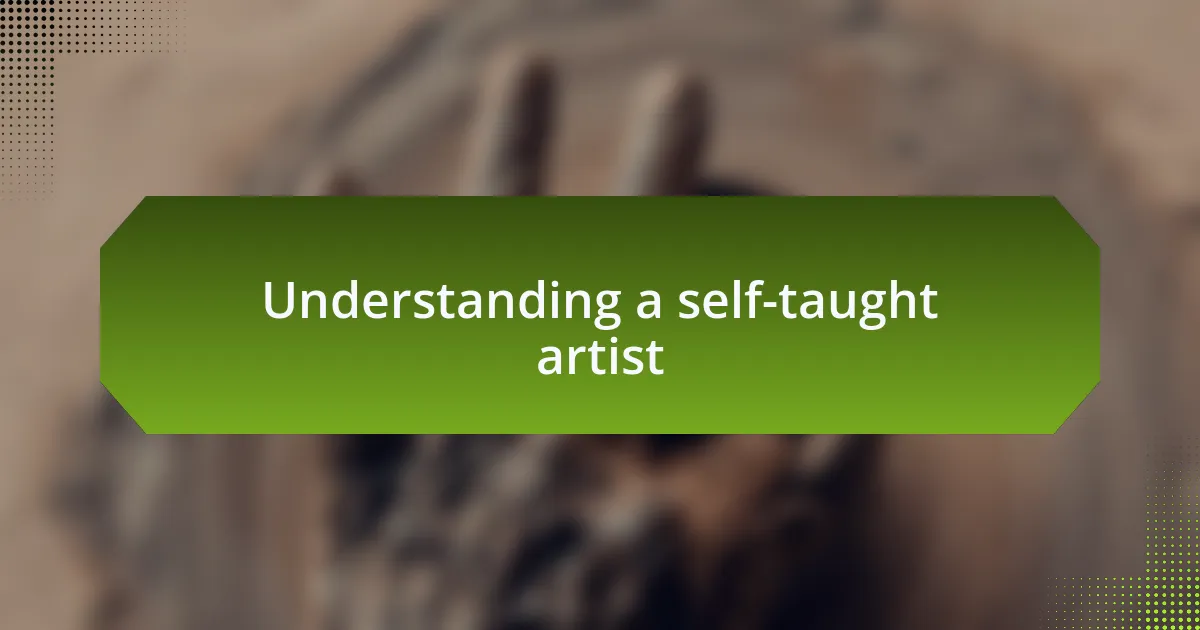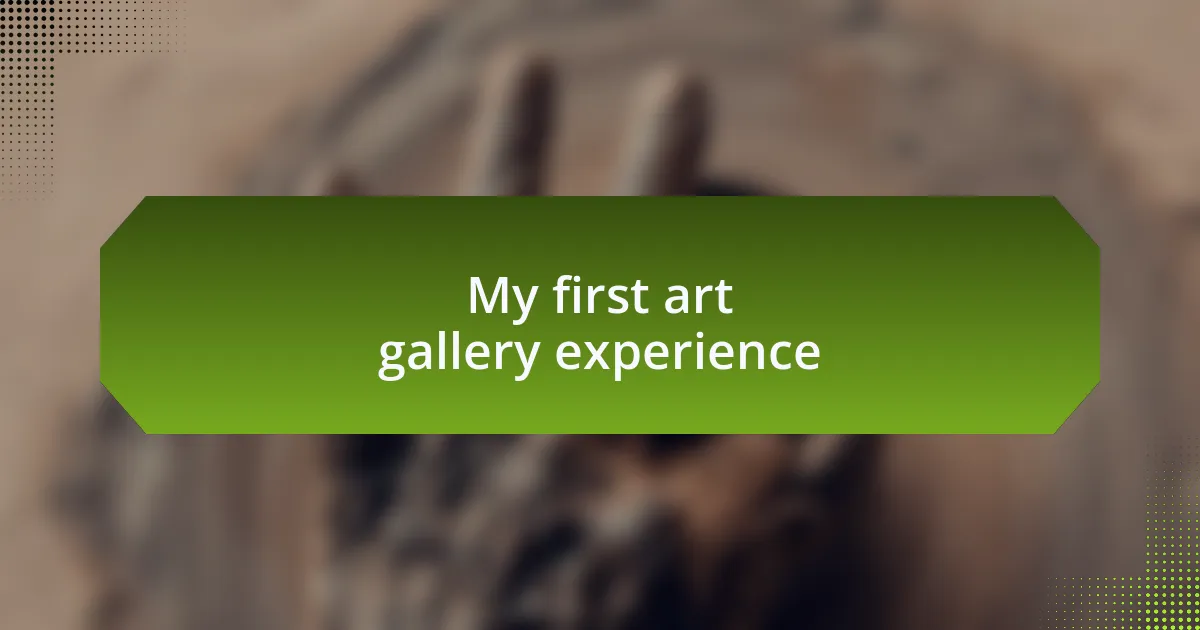Key takeaways:
- Self-taught artists often thrive through intrinsic motivation and community support, enabling them to develop unique styles and emotional connections with their work.
- Art galleries facilitate significant visibility for artists, fostering community, dialogue, and potential societal change through the display of diverse perspectives.
- Showcasing art publicly boosts artists’ confidence and encourages valuable connections with audiences, enhancing both personal growth and collaborative opportunities.
- Challenges for self-taught artists include navigating technical skill gaps, experiencing self-doubt, and often lacking external feedback, making the creative journey more solitary.

Understanding a self-taught artist
Navigating the world as a self-taught artist is a unique experience filled with both challenges and triumphs. I remember the first time I held a paintbrush, feeling a mix of excitement and intimidation. What if I simply couldn’t capture what I envisioned? That doubt was a common thread in my journey, but it pushed me to experiment and find my own voice through trial and error.
Self-taught artists often have an intrinsic motivation, fueled by a passion for creation rather than formal instruction. I once spent countless nights in my small studio, tinkering with colors and techniques, all while wondering if what I was creating truly mattered. This self-driven exploration allowed me to develop a style that resonates with my emotions, making each piece a reflection of my thoughts and experiences.
Furthermore, there’s a profound sense of community among self-taught artists. I’ve connected with others who share similar stories and frustrations, creating a network of support. How often do we find solace in knowing someone else has walked a similar path? These connections not only provide encouragement but also spark inspiration, further enriching our artistic journey.

Importance of art galleries
Art galleries play a crucial role in bridging the gap between artists and the public. I recall my first encounter with an exhibition, walking among artworks that spoke directly to my heart. It was a profound realization that my creations, too, could ignite emotions in others—a magical experience that art galleries facilitate.
Moreover, galleries provide a platform to showcase diverse perspectives and foster dialogue about important issues. I often find myself pondering: how can art influence societal change? Art spaces encourage conversations that might otherwise go unheard. They invite viewers to reflect on their realities and engage in different narratives through the lens of creativity.
Additionally, galleries support artists by offering visibility and recognition. I remember the thrill of having my work displayed for the first time; it felt like a pivotal moment in my artistic journey. When artists gain exposure, it allows their stories and unique styles to be seen, celebrated, and appreciated—encouraging them to keep creating and evolving.

Benefits of showcasing art
Showcasing art can be incredibly empowering for an artist. I remember my first gallery showing, standing nervously beside my pieces as visitors engaged with my work. Each compliment felt like a burst of encouragement, boosting my confidence and affirming that my voice mattered in the artistic community. Isn’t it fascinating how a simple exhibit can validate our creativity?
Beyond personal growth, presenting art publicly helps build connections between artists and their audience. I’ve often found that conversations sparked by my pieces led to unexpected collaborations and friendships. Have you ever noticed how a single artwork can resonate differently with each viewer? Showcasing art allows for these unique interpretations, enriching not just the viewers but also the creators themselves.
Moreover, sharing art in a gallery setting fosters a sense of belonging among artists. I vividly recall the excitement of being surrounded by fellow creatives who understood my journey. It reminded me that I wasn’t alone in my struggles and triumphs. The gallery became a space of community, where exchanging ideas and experiences could thrive—what better way to nurture growth than through artistic camaraderie?

Challenges of being self-taught
Being self-taught often feels like navigating a maze without a map. I remember countless evenings spent in front of my canvas, struggling to grasp techniques that came naturally to my formally trained peers. It can be disheartening when you realize that while your passion drives you, the technical skills can feel just out of reach. Have you ever faced that moment of frustration when you know what you want to create, but the tools to bring that vision to life seem elusive?
Another challenge lies in the lack of external feedback. I think back to times when I hesitated to share my work, fearing that without a mentor’s support, my pieces might fall flat. Listening to constructive criticism is vital for growth, yet for a self-taught artist, those insights often come few and far between. It’s a lonely road at times, and without encouragement from others, I found myself second-guessing my choices.
Moreover, there’s the weight of self-doubt that lingers in the back of my mind. Each time I paint a new piece, I can’t help but wonder if I’m on the right path. This internal dialogue can be exhausting. Do you ever feel that uncertainty creeping in, making you question your abilities? It’s a struggle I’ve learned to acknowledge; embracing imperfections has become a part of my creative journey.

My first art gallery experience
I still vividly remember my first visit to an art gallery—it was a whirlwind of emotions. Walking through those elegantly lit rooms, surrounded by incredible works, I felt a mix of excitement and intimidation, as if I were an intruder in a sacred space. Have you ever stepped into a room filled with your dreams and aspirations, only to feel small in comparison?
One piece that stood out to me—a vibrant landscape bursting with color—made me realize the power of artistic expression. I kept thinking about how the artist conveyed such emotion through brush strokes and color choices, igniting a spark within me. Did they experience the same doubts I did as a self-taught artist? It was a transformation inside of me, a moment when I saw the possibilities of what I could create if I embraced my own journey.
Leaving the gallery, I felt a renewed sense of purpose. I was inspired not just by the art itself, but by the stories behind each piece. This first experience taught me that every artist, regardless of their training, has something unique to offer. It became clear to me that my path, filled with challenges and uncertainties, was just as valuable as anyone else’s. What a liberating thought that was!

Tips for displaying your work
When displaying your work, it’s essential to consider the environment. I once hung one of my favorite pieces in a room with muted walls, and the art seemed to breathe in that space. Have you ever thought about how colors and textures around your artwork can influence its perception? I realized that proper lighting, whether natural or artificial, can truly enhance the colors and details of your art, allowing it to shine.
Another tip is to create a narrative through your display. I found that grouping pieces by theme or color can tell a story that engages viewers on a more personal level. It’s a bit like curating a personal exhibition; how do you want your audience to feel as they move through your collection? Allowing your work to speak in tandem can create a more immersive experience, drawing people in and making them linger.
Lastly, don’t shy away from experimenting with different arrangements. I remember reconfiguring my first exhibition several times, trying to find the perfect flow. It’s like a dance between the art and the space; have you ever rearranged your furniture only to discover it transformed the entire room? Each change in your display can evoke new emotions and reactions—embrace that creative exploration!